The conversation prior to the match between France and Australia was surrounded by criticism, debate and doubts about what could be the curse of the champions who even before the World Cup started, was already beginning to feel the effects of the curse, as some people said, after the plague of injuries from important players, which meant casualties such as Karim Benzema, Presnel Kimpembé, N’Golo Kanté, Christopher Nkunku and even in today’s game, Lucas Hernández, who will miss the entire season according to reports.
Didier Deschamps, despite his success in the last World Cup, plus the squad that he has full of talent, has been loaded with a lot of criticism about a very inoffensive, pragmatic and boring football, and even, with very dubious call-ups according to the opinion of certain fans. However, the work that was done against Australia, not only tactically but also mentally to come back from the game, was a very good one for the Frenchmen who beat the obscure and dark streak of the champion’s curse.
Australia, for their part, did not show anything bad in their first minutes of endurance after the goal was scored, where they were brave and proactive when they had the ball, but the depth of French talent passed over them the instant they were able to score the equalizer against through a header from Adrien Rabiot.
The match ended 4-1, with quite an interesting performance by France, who, harshly criticised for not being so offensive, managed to get three gigantic points, scoring four past their opponents and only conceding one, on a day where surprises were a constant, with the victory of Saudi Arabia and the draw between Tunisia and Denmark. In this tactical analysis, we dive into the tactics of both teams and see how Didier Deschamps’s France won the first game of the group stage.
Lineups
Deschamps chose a 4-2-3-1 that he normally used in the preparatory games before the World Cup. Hugo Lloris started again in goal for the National Team, accompanied by a defence from right to left of Benjamin Pavard, Ibrahima Konaté, Dayot Upamecano and Lucas Hernández, who was later replaced by his brother, Théo; The midfield was composed of a double-pivot with Adrien Rabiot and the tough Aurélien Tchouameni, who were responsible to provide balls to Kylian Mbappé, Antoine Griezmann, Ousmane Dembele and Olivier Giroud in attack.
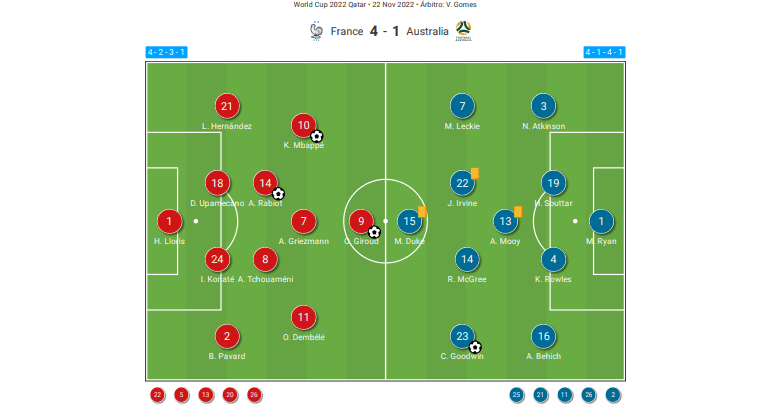
Graham Arnold for his part deployed a 4-3-3 with Matthew Ryan in goal, Nathaniel Atkinson and Aziz Behich on the wings as full-backs, completing the back-four with Harry Souttar and Kye Rowles. The midfield was made up of the talented and technical Aaron Mooy, Jackon Irvine and Riley McGree, joined by Matthew Leckie, Craig Goodwin and Mitchell Duke in attack.
How Australia knocked off first and post-moves by France
Australia found themselves quite comfortable on the ball, against a France that could not find the correct defensive setting from the opening moment of the match. Graham Arnold’s men sought to have control of the ball and overcome the French midfield through triangulations from the inside out with Aaron Mooy as executor and commander of possession.
And of course, Mooy was the one who dictated the tempo of the plays, decelerations and revitalization of his team’s possessions, since he was the key to managing them. However, Australia’s first goal wasnt’ executed with central combinations and from the floor as was being tried, despite the positioning of their wingers being just right for this type of action. Overload the centre channels to pin France there and execute diagonals, in this case, Harry Souttar, who found Matthew Leckie wide open who ran and crossed it to Craig Goodwin who scored a brilliant goal, ending a wing-to-wing progression.
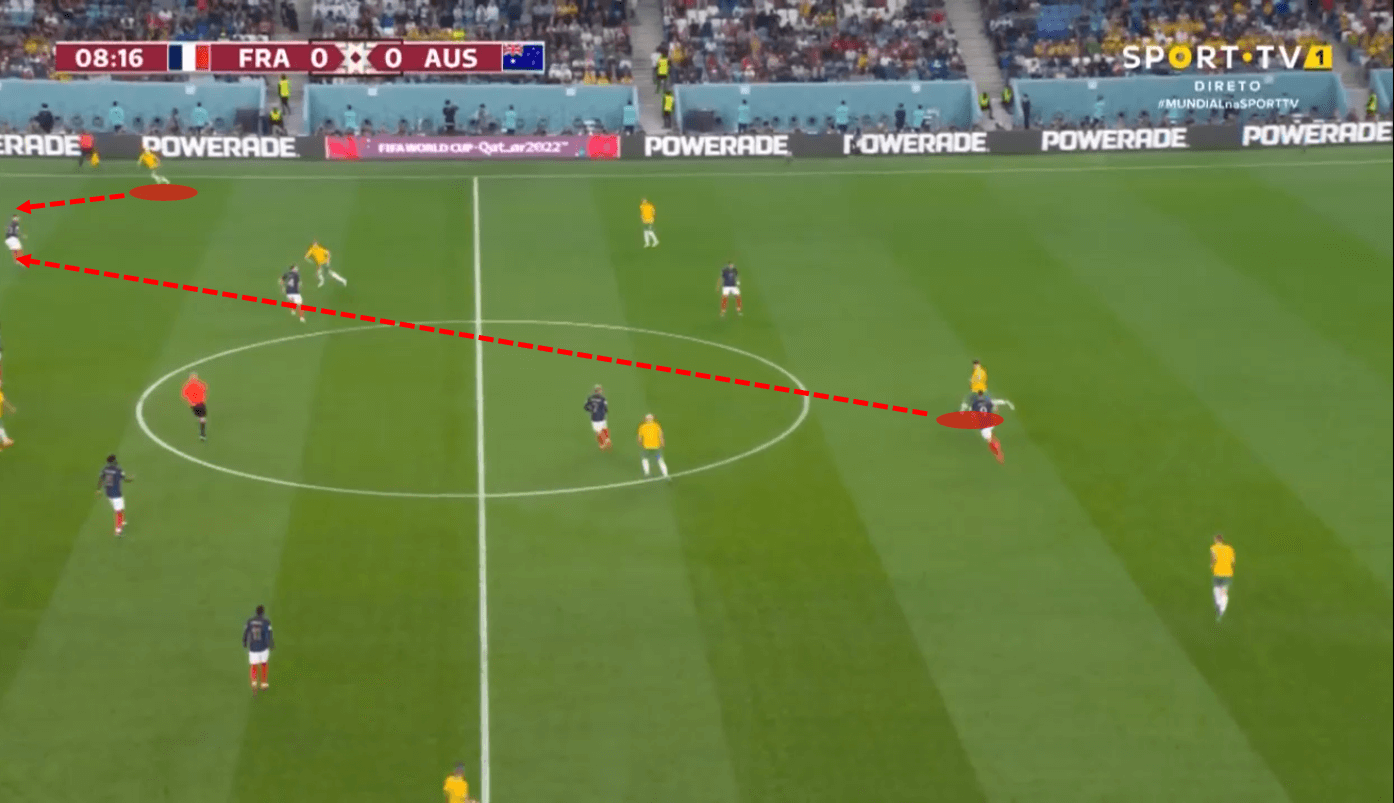
Beyond the loss of Lucas Hernández due to injury, his brother Théo absolutely demonstrated in this match why he should start on that flank of the pitch. His wide-open positioning, accompanied by the centralized positions of Kylian Mbappé, as well as the overtaking of more advanced areas by Adrien Rabiot, specifically in the half-spaces, were key to making Théo receive the ball with space to run. This was almost a sure shot-opportunity for France.
This image perfectly shows us the movements that France began to carry out to knock down Australia’s defensive block after the goal. Griezmann descended into the initial phase of the build-up, where he would make constant moves to receive the ball and find passing options with the pitch in front.
Since Griezmann managed to drop deep and be a viable option for Tchouameni, he activates him to the left side, where he finds the ball, drives it and executes a brilliant lofted pass for Théo Hernández’s run into space.
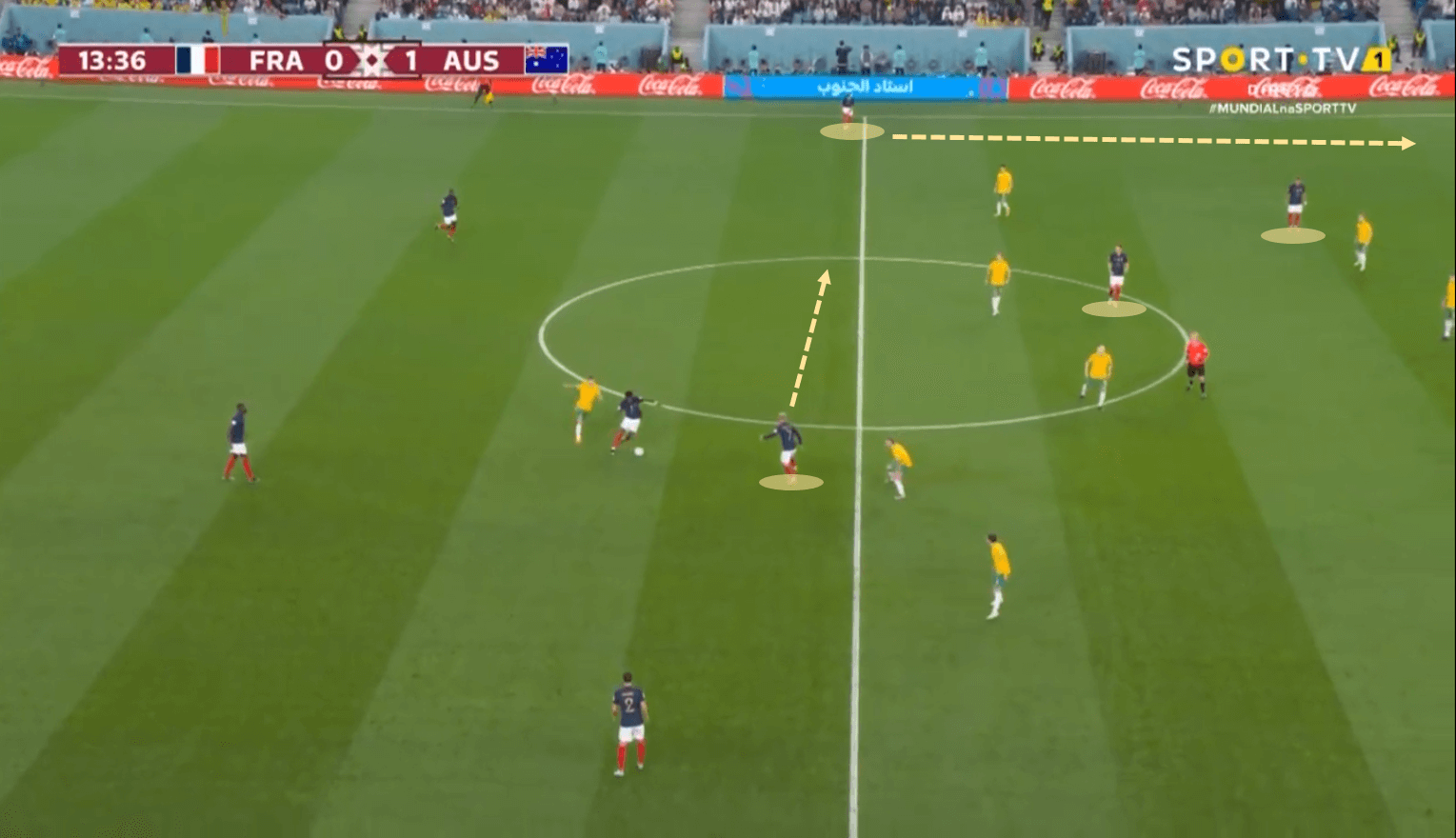
This isolated and wide positioning of Théo Hernández on the wing was intended to stretch Australia and generate confusion on the full-back as he was wondering whether to go and mark the AC Milan player or remain more centrally where Kylian Mbappé was looking to receive the ball. In any of the two cases, it was a problem as you can’t leave these two players with space to receive.
This play was another that was seen a lot in the match. Théo pins the Australian full-back on the outside, not completely but in the instant he hesitates, he leaves a space. In addition, another who is doing this is Griezmann, who drags one of the centre-backs of Australia and by not closing completely his line, Mbappé recognizes the space to run, the best feature in his game, not only for the pace but for the timing to run into this free channel.
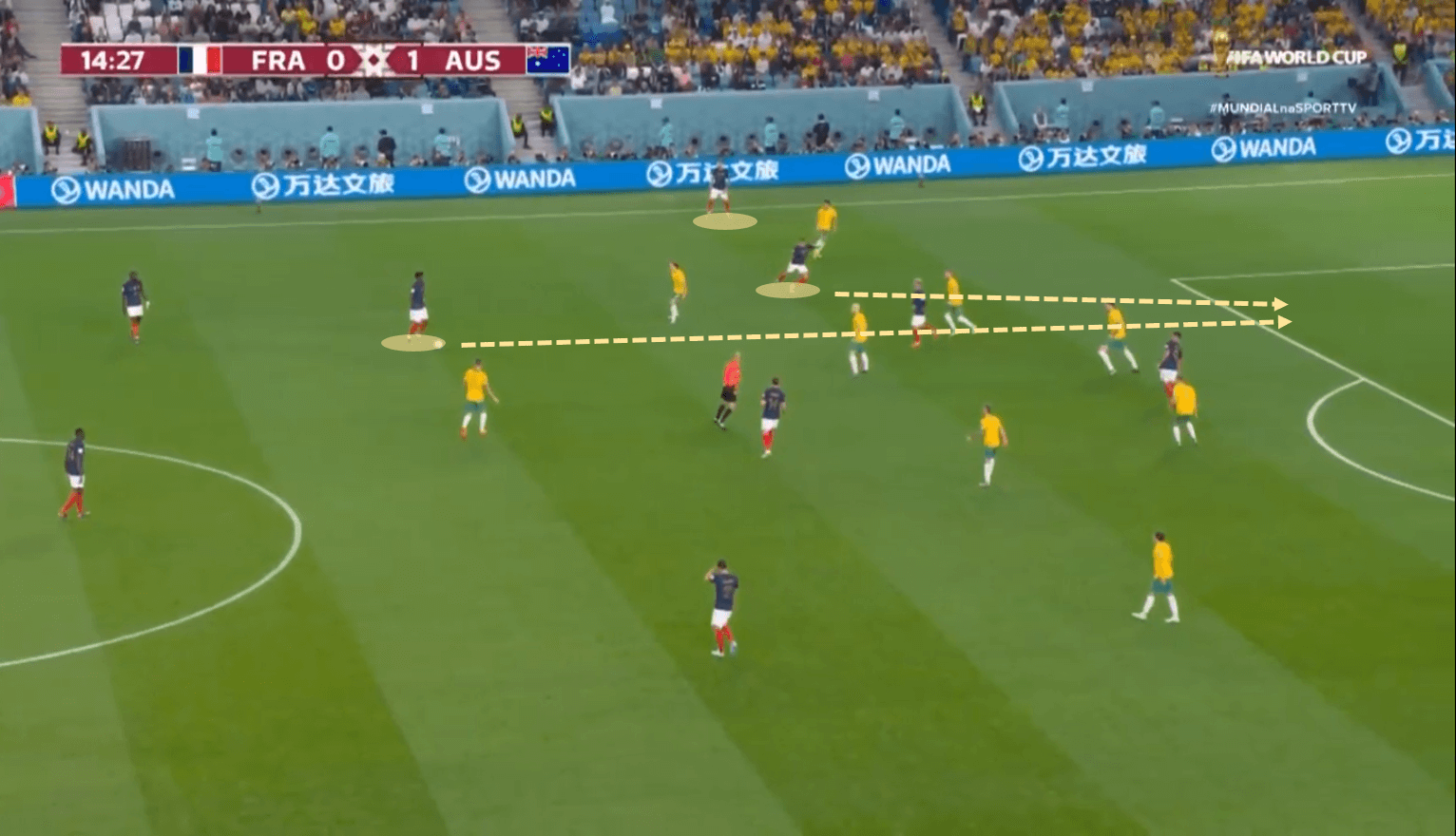
Again, we see in the following image what was the type of movement that France and Didier Deschamps planned on the pitch over the left hand-side. Griezmann went down almost like the right midfielder next to Aurélien Tchouameni. Adrién Rabiot pinned one of the rival midfielders and when the ball was played to the centre-back, in this case, Upamecano, he looked at the options. Mbappé was once again free between the lines, where he could receive and activate his teammate Théo behind the Australia defensive line.
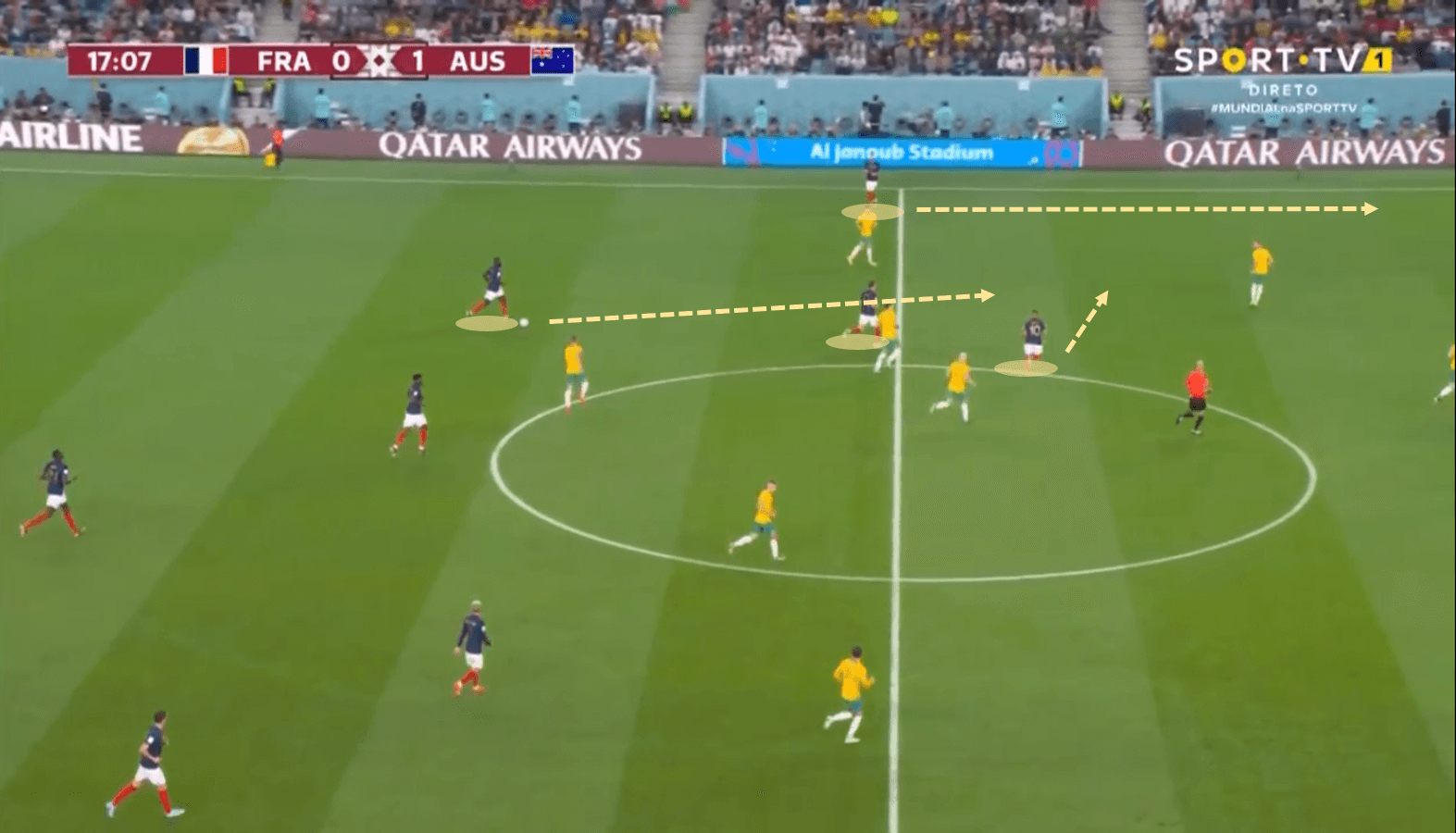
After scoring the first goal, Australia felt really overwhelmed by France, who did not allow Arnold’s men to feel comfortable with the ball, further advancing the pressing lines and with the presence of Tchouaméni in the midfield that provided a lot of balance and control when Australia tried to appear between the lines. France, which had started with Dembélé in a more defensive role on the inside, changed this with Griezmann further back and gave the team more solidity.
On the right, France also created these decoy positions, to attract players from Australia’s mid-block and create space behind them. As Griezmann descended and organised the game over the right, when Pavard, the full-back on that side, took the ball, then Antoine could raise the height on the field. This did two things: it attracted one of the rival midfielders to go for Pavard inside and Griezmann pinned his marker on the half-spaces, opening the entire outer lane for Dembélé to generate 1v1 situations.
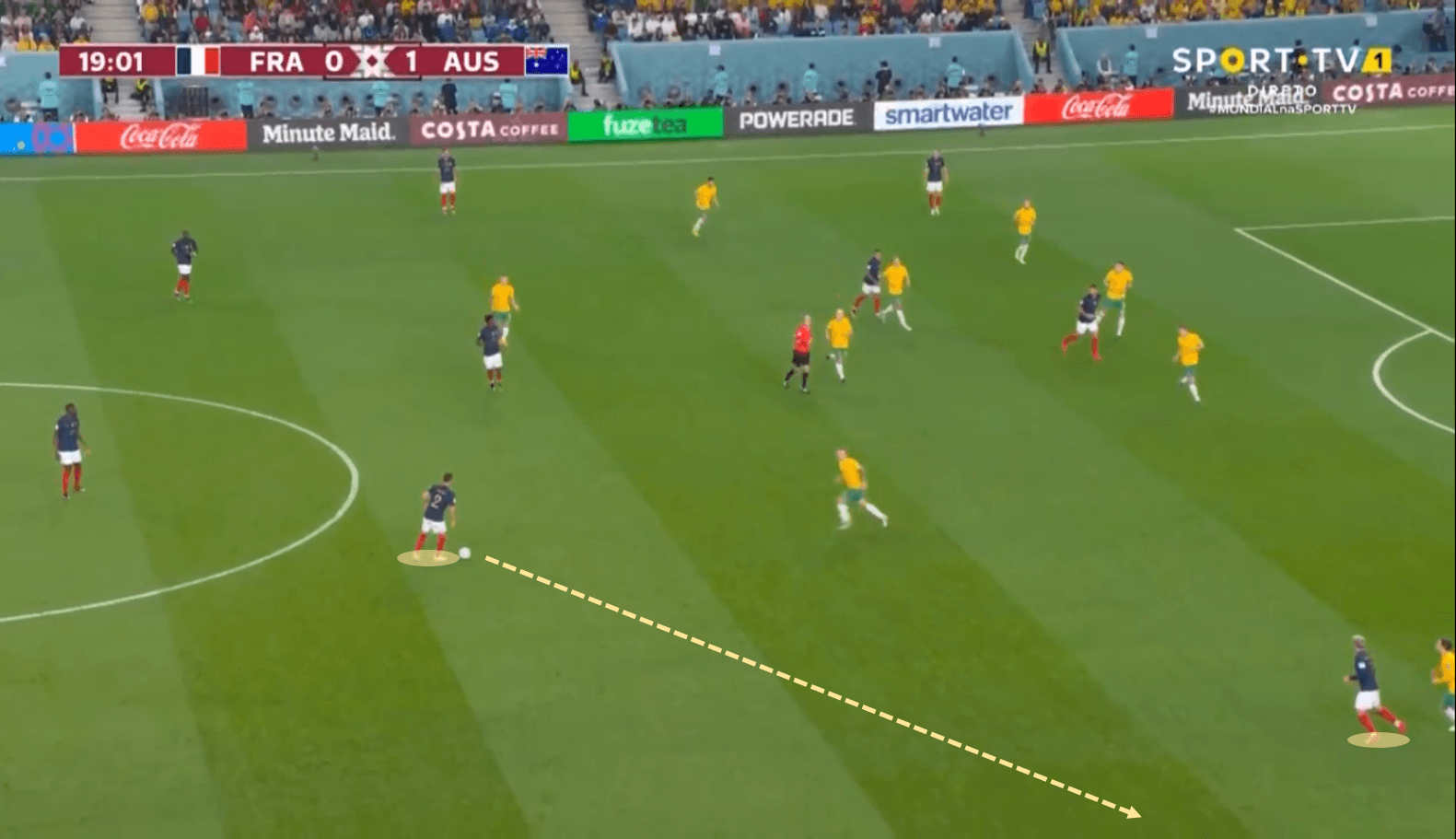
Really, after the goal, France won and showed a lot of fluidity with the ball both because of what Griezmann offered in his dynamic movements, as well as the presence of a player as explosive as Théo Hernández who provided ball-carrying, chance creation and an ability to beat pressure from his speed and imposing physique in addition to what a player of the stature of Mbappé can offer you close to him.
One of the most interesting but perhaps less flashy roles was the one of Adrien Rabiot who, without receiving the ball much and contributing to the build-up of the game for his team, his mere presence in more advanced areas occupying spaces and pinning rival players opened the door for his team to circulate the ball very quickly, making teammates like Mbappé be in contact with the ball with time and space. Even later, he was part of the first two goals and a lot due to his positioning.
The come-back and occupation of spaces throughout the match
As time passed in the match, France became much more overwhelming and mobile. Far from wanting to stay with these static movements by Rabiot, Théo, Pavard and company, when they began to sit more in the last third in a high block, multiple rotations and occupation of spaces through these movements began to emerge.
When France placed the high block, the exchanges of channels and zones were constant. Griezmann travelled from side to side, the full-backs went inside and outside as overlapping or underlapping players, and Rabiot’s role became increasingly interesting as when Théo was further back on the left and Mbappé on the inside, he occupied this wide area as a winger. At other times it was Mbappé there and him on the inside. All this began to generate chaos for Australia that could not contain the French dynamism.
Football likewise always shows that it can be kind of strange, with all that France sought to generate through open play, the first goal came after a rebound from a set-piece, in which Juventus‘ player Rabiot was able to head a great cross from Théo Hernández with his prodigious left foot. The equaliser had already arrived and it was clear that with the superiority that was shown on the field, the game had taken a complete turn at this moment.
Rabiot’s more advanced role on the field was seen in the second goal, in which he was able to assist Olivier Giroud. France sought to be more aggressive in their marking, going to mark hard and close to Australia’s first passing lane. Thus, Rabiot was able to win the ball in the left zone, where he found Mbappé who returned it to him with the back heel, and he was able to penetrate the box to assist Giroud.
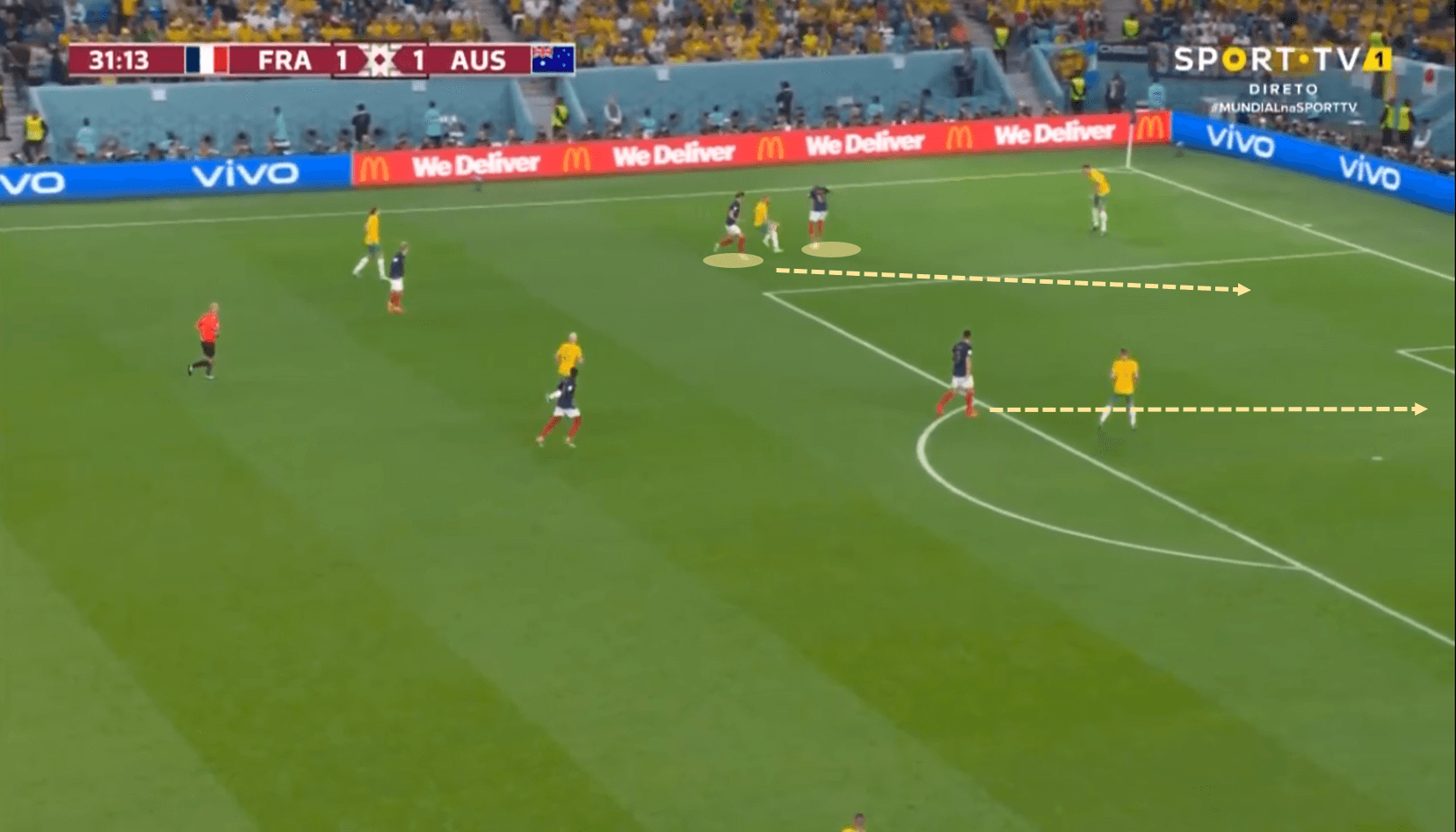
France tried to be even more direct in the second half, trying to make four to seven passes between midfielders and defenders to later execute passes between to the outside channels or diagonals to wingers. In the case of Théo, who had a fantastic game, he was one of the most sought after in the French team. He constantly appeared free on the outside in his left wide zone and penetrated the box whenever he could, where he looked to make cut-back crosses that were received and shot after several times, yet failed to go on target or were blocked en route.
The image below shows us once again how France found Théo on the outside, but this time, was much more direct with their centre-backs, without going through a previous pass between the lines to Mbappé or Griezmann, but directly throwing balls into space for Théo to run.
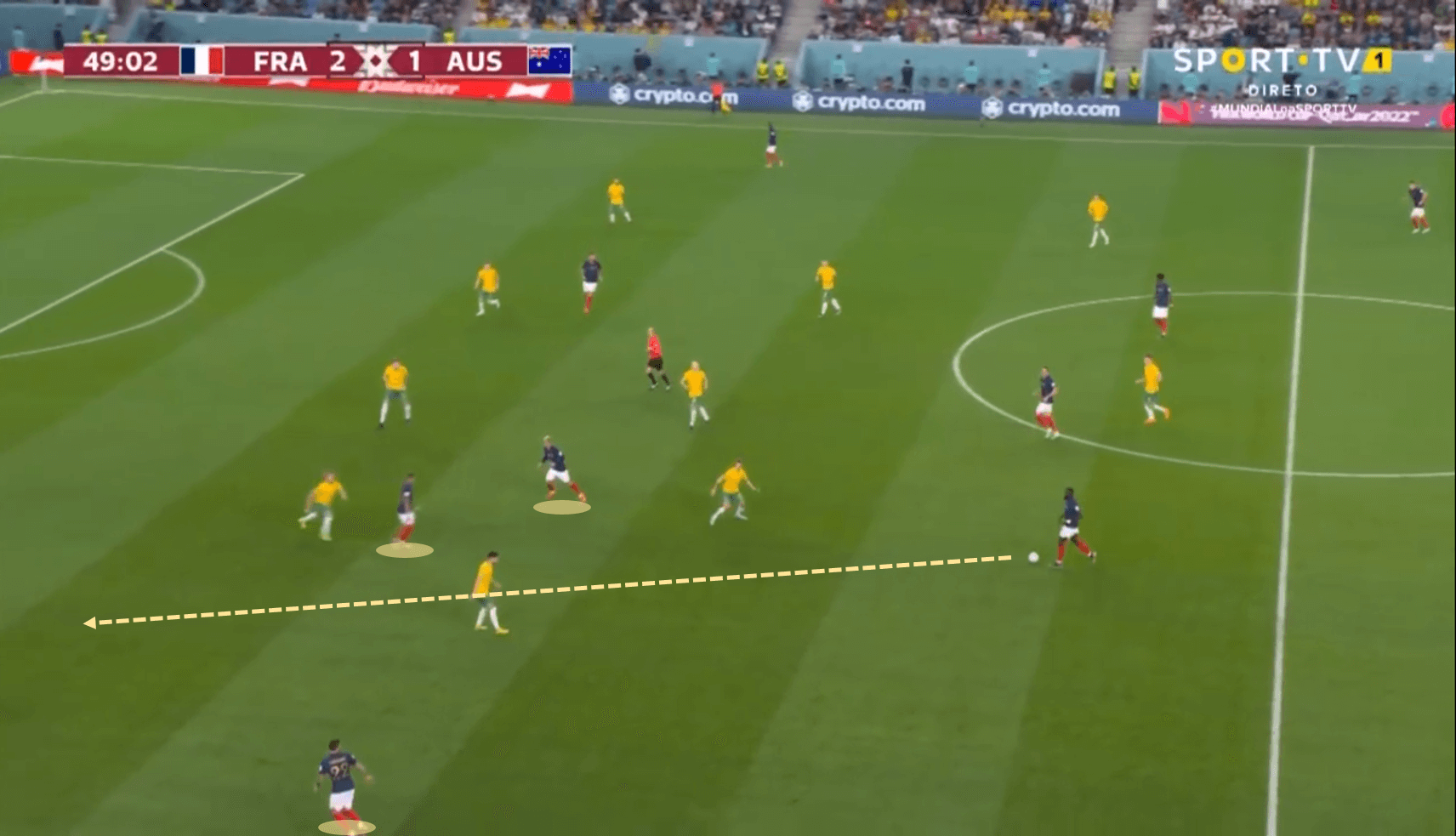
With Didier Deschamps’ team much more comfortable and established in the last third, Kylian Mbappé was able to be closer to the rival box, and not so much within the passing circuits and contributing to the build-up of the play. This meant a very high danger for Australia because it was very close to the most threatening area he could be, where it was looking to activate on the outside, inside and making one-two combinations with Olivier Giroud, who in this role of playing with their backs is wonderful.
The third goal was scored in the way shown above, in which Théo received a much more direct pass from his centre-back. With Australia’s mid-block all but broken and devastated, spaces were appearing everywhere. Théo’s receptions on the outside stretched Arnold’s team a lot and this meant that Mbappé could run between the centre-back intervals.
The play prior to the third goal is shown here. Théo immediately after receiving activated Mbappé behind the central defenders who executed a low cross that travelled the entire penalty box and was taken by Dembélé at the other side who was able to cross it perfectly to the head of the PSG forward who scored his first and only of the match.
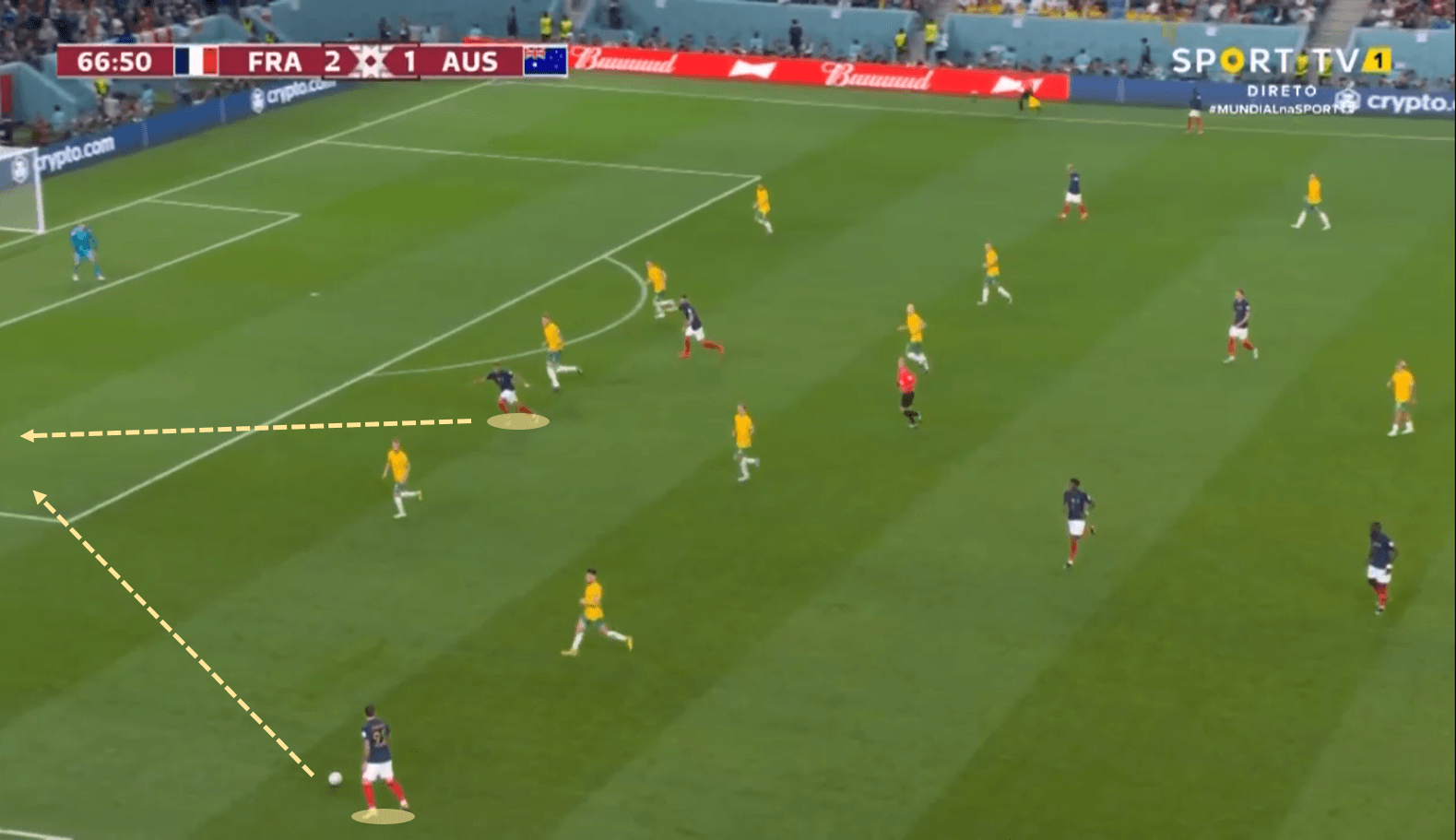
Another of the tactical adjustments that France made during the game was to drop Théo further in his zone, in order to attract one of the Australian players, thereby creating a space behind that was activated by Mbappé who, with his skills in 1v1 made a lot of difference compared to what Graham Arnold’s team proposed defensively and individually. France’s fourth and final goal came in this way, with Mbappé’s run behind and a further back position from Théo who executed a pre-assist so that once again, the 23-year-old crossed to Giroud’s head.
Conclusion
Concluding this analysis, France really proved that curses are not for them, and they don’t believe in that kind of thing either. With all the talent they have, in addition to a very large squad with a lot of quality, they continue to be the favourites to win the tournament, thanks to the chemistry that the team have played with, and arguably, the best player in the world right now, which is Kylian Mbappé.

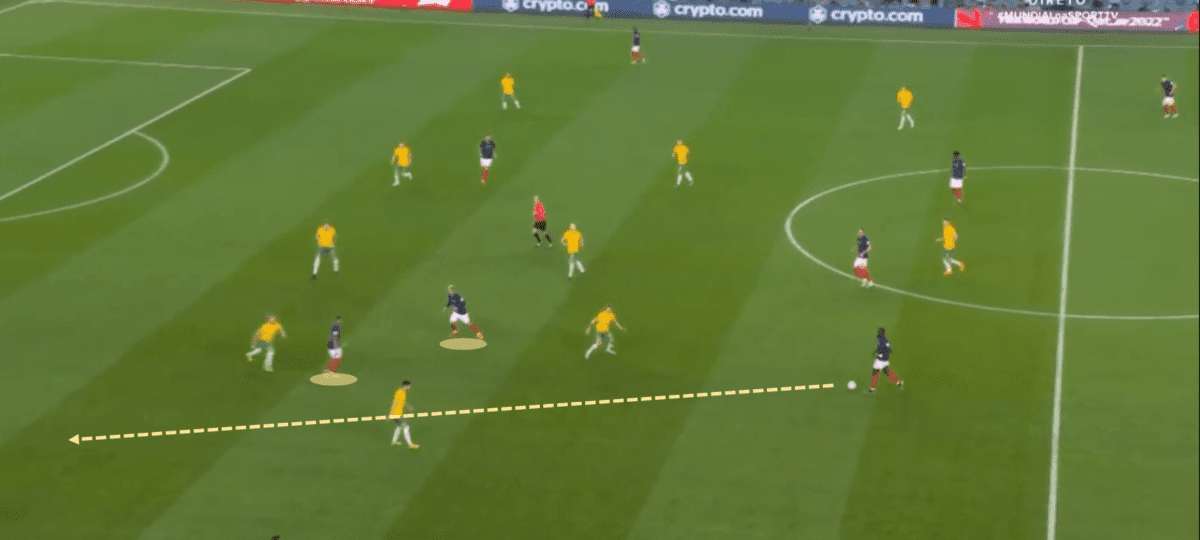




Comments